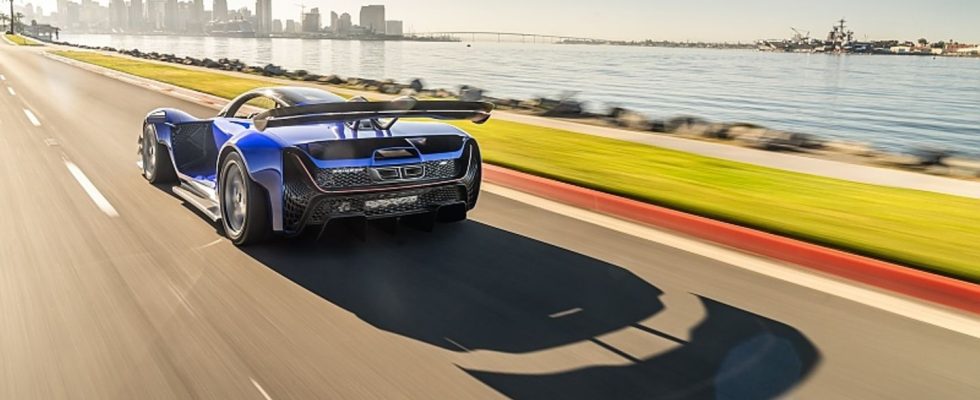Fascination: Czinger – unknown hyper athlete
The quiet high-flyer from the 3D printer
Czinger 21C
© press-inform – the press office
So far, only absolute car experts know Czinger. The small-series manufacturer from Los Angeles has been the silent star of luxury events such as the Monterey Autoweek for the past few years. Czinger are exclusive, incredibly fast and are partly created using a 3D printer.
There is nothing like clean pronunciation. Many Americans are not exactly known for this and when the multi-millionaire George from Calabas speaks about this new, spectacular sports car brand Czinger in the Malibu Bluffs parking lot at the Sunday car meeting, his parking lot neighbors just nod in boredom. You know Singer – of course. They’ve been making these cool retro Porsches based on the 964 for years – very exclusive, very fast and incredibly expensive. But George, who is in his mid-fifties, just shakes his head as the brothers mentally talk about the charismatic character of the 911 generation with air cooling and talk themselves into rage.
The quiet high-flyer from the 3D printer
No, George is talking about Czinger! Named after the two car fans Kevin and Lukas Czinger, father and son Los Angeles with an enthusiasm for cars that is unparalleled even by American standards. Founded in 2019, Czinger is exactly a decade older than the Porsche disciples from Singer, who reside in Torrance, just a half hour south. Czinger does not refine Porsches and also avoids sports cars from other brands, but similar to Koenigsegg, a Czinger is just a Czinger. Models like the debut 21C are hyper sports cars that are intended to set records in terms of driving performance. “Czinger’s vision to fundamentally change the way cars are designed and built by removing the creative constraints and limitations of tools and costs and actually making the product better for the end user deeply impressed me,” recalls David O’Connell, co-founder of the brand and responsible for the design of the models.
When the first sketches were created, Czinger’s design DNA set the goals of aesthetic purity, technical innovation and the “Zen Minimal” concept, which means that nothing belongs on the vehicle that doesn’t necessarily have to be there. Striking surfaces, as simple as they are Clear graphics create an original design that appears modern and clear and is intended to become a timeless statement in automotive design. Lots of goals and big specifications, but in addition to the design, it is primarily the performance that inspires – taking even die-hard sports car fans’ breath away .
But Czinger are not only fast, they are also expensive and exclusive. Just 80 models of the 21C are expected to be built in the coming months. The hyper athlete was created entirely on the computer; with significant support from artificial intelligence in order to best combine maximum speeds and aerodynamics. The potent hybrid drive delivers 932 kW / 1250 hp in its basic configuration. Optionally there is a slight increase in performance of a further 74 kW / 100 hp. The power-to-weight ratio promises a world record: 245 kW / 330 hp per liter of displacement. But that’s not enough. The downforce at high speeds is hardly less impressive than the design. At a speed of 305 km/h, the US flounder is pressed to the ground with a weight of two tons and could therefore also ride on the ceiling without falling down.
The basic work is done by a 2.9-liter eight-cylinder engine with electric assistance, which accelerates the hybrid from a standstill to 100 km/h in under two seconds. The 21C Vmax was derived from the Czinger 21C. This differs from its brother in its extended and aerodynamically oriented rear profile. The Vmax forgoes solid aerodynamic elements in favor of a smooth body design, which allows it to capture even more speed on the road. It takes just 27.1 seconds to reach 400 km/h. The top speed of the almost 1.4 ton American: 407 km/h. “The 21C is the most technologically advanced hypercar in the world. From the AI-driven design software with which it was developed to the patented alloys from which its structures are printed, the 21C represents more than seven years of technology development and hundreds of millions in investment,” explains Lukas Czinger, “he “Not only is it an industry leader in every respect, it also embodies a technology that will fundamentally transform the automotive industry.”
The 21C was created on computers – supercomputers and artificial intelligence. Sounds good to me – but that’s what everyone who wants to generate attention in the car industry says. But what does that actually mean? The chassis was designed generatively – meaning that every component of the 21C structure is optimized for its precise function so as not to waste a single gram of material. After each digital design is approved, it goes to manufacturing machines that print the module using 3D technology, where it is made from patented alloys. Each printed component is assembled into its final structure using laser-controlled robotic technology. The 21C chassis is intended to set records in terms of lightweight construction, materials, durability, strength and safety. This not only brings impressive performance and maximum efficiency, but also a gigantic price: over two million US dollars. After all, there is not only a spectacular hybrid athlete for maximum attention and no less impressive driving performance, but also an exclusive interior made of carbon fiber and a small storage compartment with space for a tailor-made luggage set.

